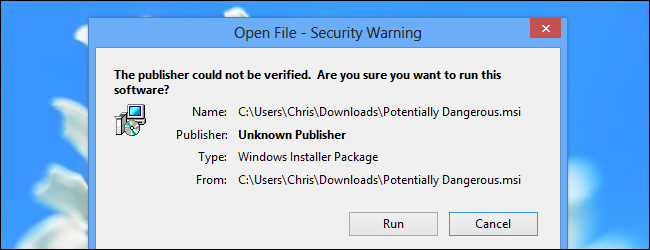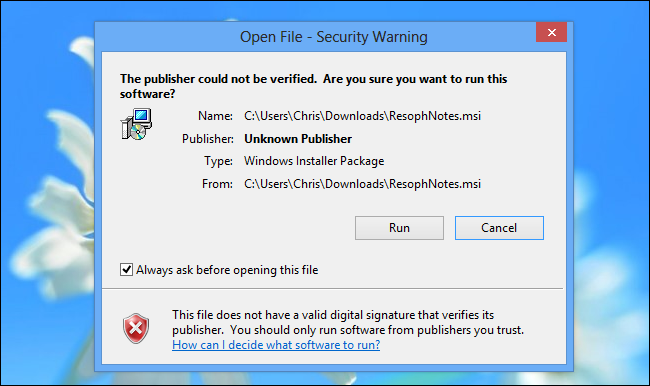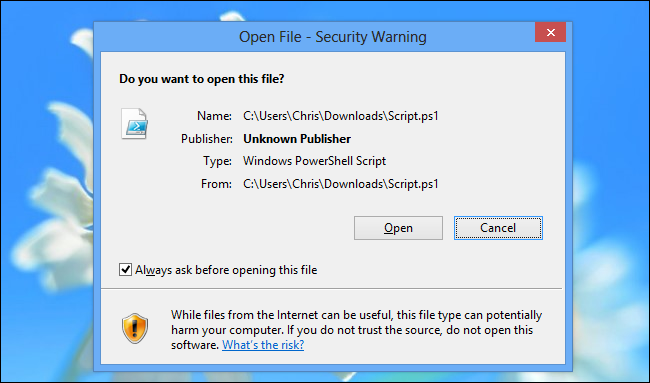Quick Links
Most people know that .exe files are potentially dangerous, but that isn’t the only file extension to beware of on Windows. There are a variety of other potentially dangerous file extensions – more than you might expect.
So Why Would I Want to Know Which Files are Dangerous?
It’s important to know which file extensions are potentially dangerous when deciding whether a file attached to an email or downloaded from the web is safe to open. Even screen saver files can be dangerous on Windows.
When you encounter one of these files, you should take extra care to make sure that you are protected. Scan with your preferred anti-virus product, or even upload it to a service like VirusTotal to make sure that there aren't any viruses or malware.
Obviously you should always have your anti-virus software running and active, and protecting you in the background -- but knowing more about some uncommon file extensions can be useful in preventing something bad from happening.
Why is a File Extension Potentially Dangerous?
These file extensions are potentially dangerous because they can contain code or execute arbitrary commands. An .exe file is potentially dangerous because it’s a program that can do anything (within the limits of Windows’ User Account Control feature). Media files – like .JPEG images and .MP3 music files – are not dangerous because they can’t contain code. (There have been some cases where a maliciously crafted image or other media file can exploit a vulnerability in a viewer application, but these problems are rare and are patched quickly.)
With that in mind, it’s important to know just what types of files can contain code, scripts, and other potentially dangerous things.
Programs
.EXE – An executable program file. Most of the applications running on Windows are .exe files.
.PIF – A program information file for MS-DOS programs. While .PIF files aren’t supposed to contain executable code, Windows will treat .PIFs the same as .EXE files if they contain executable code.
.APPLICATION – An application installer deployed with Microsoft’s ClickOnce technology.
.GADGET – A gadget file for the Windows desktop gadget technology introduced in Windows Vista.
.MSI – A Microsoft installer file. These install other applications on your computer, although applications can also be installed by .exe files.
.MSP – A Windows installer patch file. Used to patch applications deployed with .MSI files.
.COM – The original type of program used by MS-DOS.
.SCR – A Windows screen saver. Windows screen savers can contain executable code.
.HTA – An HTML application. Unlike HTML applications run in browsers, .HTA files are run as trusted applications without sandboxing.
.CPL – A Control Panel file. All of the utilities found in the Windows Control Panel are .CPL files.
.MSC – A Microsoft Management Console file. Applications such as the group policy editor and disk management tool are .MSC files.
.JAR – .JAR files contain executable Java code. If you have the Java runtime installed, .JAR files will be run as programs.
Scripts
.BAT – A batch file. Contains a list of commands that will be run on your computer if you open it. Originally used by MS-DOS.
.CMD – A batch file. Similar to .BAT, but this file extension was introduced in Windows NT.
.VB, .VBS – A VBScript file. Will execute its included VBScript code if you run it.
.VBE – An encrypted VBScript file. Similar to a VBScript file, but it’s not easy to tell what the file will actually do if you run it.
.JS – A JavaScript file. .JS files are normally used by webpages and are safe if run in Web browsers. However, Windows will run .JS files outside the browser with no sandboxing.
.JSE – An encrypted JavaScript file.
.WS, .WSF – A Windows Script file.
.WSC, .WSH – Windows Script Component and Windows Script Host control files. Used along with with Windows Script files.
.PS1, .PS1XML, .PS2, .PS2XML, .PSC1, .PSC2 – A Windows PowerShell script. Runs PowerShell commands in the order specified in the file.
.MSH, .MSH1, .MSH2, .MSHXML, .MSH1XML, .MSH2XML – A Monad script file. Monad was later renamed PowerShell.
Shortcuts
.SCF – A Windows Explorer command file. Could pass potentially dangerous commands to Windows Explorer.
.LNK – A link to a program on your computer. A link file could potentially contain command-line attributes that do dangerous things, such as deleting files without asking.
.INF – A text file used by AutoRun. If run, this file could potentially launch dangerous applications it came with or pass dangerous options to programs included with Windows.
Other
.REG – A Windows registry file. .REG files contain a list of registry entries that will be added or removed if you run them. A malicious .REG file could remove important information from your registry, replace it with junk data, or add malicious data.
Office Macros
.DOC, .XLS, .PPT – Microsoft Word, Excel, and PowerPoint documents. These can contain malicious macro code.
.DOCM, .DOTM, .XLSM, .XLTM, .XLAM, .PPTM, .POTM, .PPAM, .PPSM, .SLDM – New file extensions introduced in Office 2007. The M at the end of the file extension indicates that the document contains Macros. For example, a .DOCX file contains no macros, while a .DOCM file can contain macros.
This isn’t an exhaustive list. There are other types of file extensions – like .PDF – that have had a string of security problems. However, for most of the file types above, there's just no securing them. They exist to run arbitrary code or commands on your computer.
As if the amount of potentially dangerous file extensions to keep track of wasn’t enough, a vulnerability in Windows allows malicious individuals to disguise programs with fake file extensions.





![docm-vs-docx[4]](https://static1.howtogeekimages.com/wordpress/wp-content/uploads/2013/02/docm-vs-docx4.png)